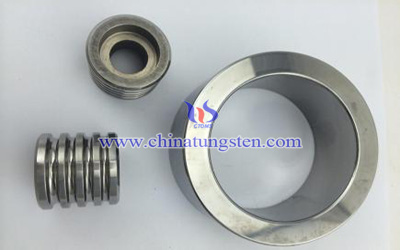Sintering Mechanisms of Tungsten Carbide
- Details
- Category: Tungsten Information
- Published on Tuesday, 20 February 2018 19:04
The sintering of tungsten carbide is a complex process, where exists two or more than two mechanisms at the same time. Under certain conditions, a mechanism dominates and restricts the speed of the whole sintering process. Its kinetic equation can be used as an approximate description of the actual sintering process. But this approximation is still very rough, which requires a systematic and comprehensive theoretical description of the sintering process.

Limitation of Single Sintering Mechanism to Describe the Sintering Process
The general formula of sintering kinetics is xm/an=F(T)t. The M and N are not integers, and the various sintering mechanisms give only a definite value. When the index is used, the problem of how to match is encountered.
All the existing sintering theories are better described in a certain stage of sintering, and there is a deviation in the interpretation of the whole sintering process. As each sintering theory has less consideration for the sintering process, and there is no comprehensive consideration of the actual parameters, there is a deviation between theory and practice.
Presently, the single sintering theory only points out all kinds of possible material migration mechanisms and their corresponding dynamics in the process of sintering. The latter can be applied only when a certain institution takes advantage. Different powders, different granularity, different sintering temperatures or different stages of isothermal sintering, and different sintering atmospheres and ways, such as external stress, may change the actual mechanism and dynamics of sintering.
In view of the limitations of the single sintering theory in application, many scholars have proposed a comprehensive theory of sintering. The most famous of these are Luo Kelan's volume diffusion equation and the theory of the comprehensive effect of the diffusion, flow and physical and chemical reactions of our scholar Huang Peiyun.
Theory of Rockland
Rockland believes that sintering is the result of the joint action of volume diffusion and surface diffusion. The diffusion equation of sintering is as follows.
x^5/5-(K2x^3)/3+〖K2〗^2 x-〖K2〗^(5/2) arctg(x/〖K2〗^(1/2) )=K1t
Where K1=(4D1γδ3a2)/(KT),
K2=(1.21δaD2)/D1,
D1 is the bulk diffusion coefficient,
D2 is the surface diffusion coefficient.
Theory of Huang Peiyun
He pointed out that sintering is a comprehensive action of diffusion, flow and physical and chemical reactions (evaporation condensation, dissolution deposition, adsorption desorption, chemical reaction). The three basic processes of diffusion, flow, physical and chemical reaction cause the change of the concentration of the sintered material and are expressed by mathematical equations.
Spread ∂c/∂t=D*∂2c/∂x2(2)
Flow ∂c/∂t=-v*∂c/∂x(3)
Physicochemical Process ∂c/∂t=-Kc(4)
- Tungsten Carbide Manufacturer & Supplier, Chinatungsten Online: tungsten-carbide.com.cn
- Tungsten News & Prices of China Tungsten Industry Association: www.ctia.com.cn
- Molybdenum News & Price: news.molybdenum.com.cn
- Tel.: 86 592 5129696; Fax: 86 592 5129797; Email: sales@chinatungsten.com



 sales@chinatungsten.com
sales@chinatungsten.com